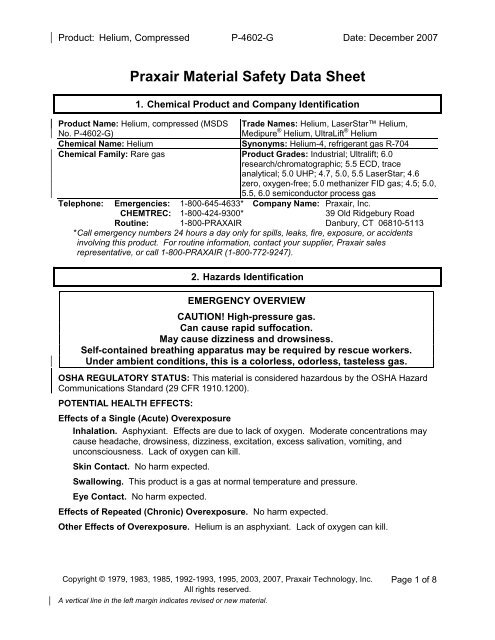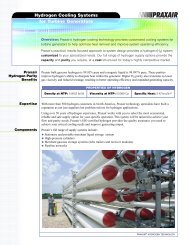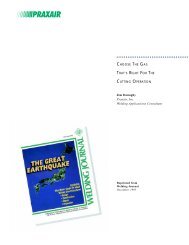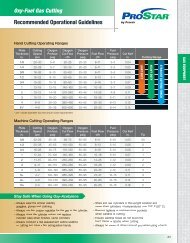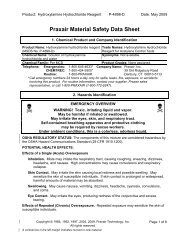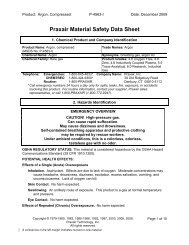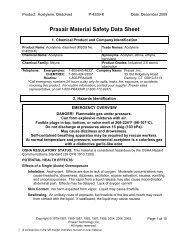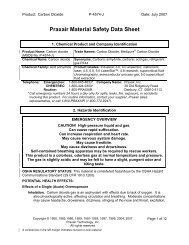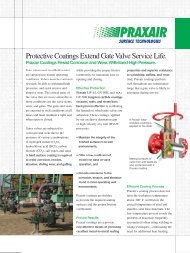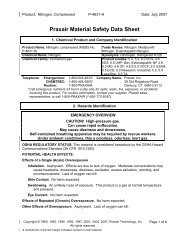Helium Material Safety Data Sheet Provided by Praxair, Supplier of ...
Helium Material Safety Data Sheet Provided by Praxair, Supplier of ...
Helium Material Safety Data Sheet Provided by Praxair, Supplier of ...
Create successful ePaper yourself
Turn your PDF publications into a flip-book with our unique Google optimized e-Paper software.
Product: <strong>Helium</strong>, Compressed P-4602-G Date: December 2007<br />
<strong>Praxair</strong> <strong>Material</strong> <strong>Safety</strong> <strong>Data</strong> <strong>Sheet</strong><br />
1. Chemical Product and Company Identification<br />
Product Name: <strong>Helium</strong>, compressed (MSDS Trade Names: <strong>Helium</strong>, LaserStar <strong>Helium</strong>,<br />
No. P-4602-G)<br />
Medipure ® <strong>Helium</strong>, UltraLift ® <strong>Helium</strong><br />
Chemical Name: <strong>Helium</strong> Synonyms: <strong>Helium</strong>-4, refrigerant gas R-704<br />
Chemical Family: Rare gas Product Grades: Industrial; Ultralift; 6.0<br />
research/chromatographic; 5.5 ECD, trace<br />
analytical; 5.0 UHP; 4.7, 5.0, 5.5 LaserStar; 4.6<br />
zero, oxygen-free; 5.0 methanizer FID gas; 4.5; 5.0,<br />
5.5, 6.0 semiconductor process gas<br />
Telephone: Emergencies: 1-800-645-4633* Company Name: <strong>Praxair</strong>, Inc.<br />
CHEMTREC: 1-800-424-9300* 39 Old Ridgebury Road<br />
Routine: 1-800-PRAXAIR Danbury, CT 06810-5113<br />
* Call emergency numbers 24 hours a day only for spills, leaks, fire, exposure, or accidents<br />
involving this product. For routine information, contact your supplier, <strong>Praxair</strong> sales<br />
representative, or call 1-800-PRAXAIR (1-800-772-9247).<br />
2. Hazards Identification<br />
EMERGENCY OVERVIEW<br />
CAUTION! High-pressure gas.<br />
Can cause rapid suffocation.<br />
May cause dizziness and drowsiness.<br />
Self-contained breathing apparatus may be required <strong>by</strong> rescue workers.<br />
Under ambient conditions, this is a colorless, odorless, tasteless gas.<br />
OSHA REGULATORY STATUS: This material is considered hazardous <strong>by</strong> the OSHA Hazard<br />
Communications Standard (29 CFR 1910.1200).<br />
POTENTIAL HEALTH EFFECTS:<br />
Effects <strong>of</strong> a Single (Acute) Overexposure<br />
Inhalation. Asphyxiant. Effects are due to lack <strong>of</strong> oxygen. Moderate concentrations may<br />
cause headache, drowsiness, dizziness, excitation, excess salivation, vomiting, and<br />
unconsciousness. Lack <strong>of</strong> oxygen can kill.<br />
Skin Contact. No harm expected.<br />
Swallowing. This product is a gas at normal temperature and pressure.<br />
Eye Contact. No harm expected.<br />
Effects <strong>of</strong> Repeated (Chronic) Overexposure. No harm expected.<br />
Other Effects <strong>of</strong> Overexposure. <strong>Helium</strong> is an asphyxiant. Lack <strong>of</strong> oxygen can kill.<br />
Copyright © 1979, 1983, 1985, 1992-1993, 1995, 2003, 2007, <strong>Praxair</strong> Technology, Inc. Page 1 <strong>of</strong> 8<br />
All rights reserved.<br />
A vertical line in the left margin indicates revised or new material.
Product: <strong>Helium</strong>, Compressed P-4602-G Date: December 2007<br />
Medical Conditions Aggravated <strong>by</strong> Overexposure. The toxicology and the physical and<br />
chemical properties <strong>of</strong> helium suggest that overexposure is unlikely to aggravate existing<br />
medical conditions.<br />
CARCINOGENICITY: <strong>Helium</strong> is not listed <strong>by</strong> NTP, OSHA, or IARC.<br />
POTENTIAL ENVIRONMENTAL EFFECTS: None known. For further information, see section<br />
12, Ecological Information.<br />
3. Composition/Information on Ingredients<br />
This section covers materials <strong>of</strong> manufacture only. See sections 8, 10, 11, and 16 for<br />
information on <strong>by</strong>-products generated during use in welding and cutting.<br />
See section 16 for important information about mixtures.<br />
COMPONENT CAS NUMBER CONCENTRATION<br />
<strong>Helium</strong> 7440-59-7 >99%*<br />
*The symbol > means “greater than.”<br />
4. First Aid Measures<br />
INHALATION: Immediately remove to fresh air. If not breathing, give artificial respiration. If<br />
breathing is difficult, qualified personnel may give oxygen. Call a physician.<br />
SKIN CONTACT: An unlikely route <strong>of</strong> exposure. This product is a gas at normal temperature<br />
and pressure.<br />
SWALLOWING: An unlikely route <strong>of</strong> exposure. This product is a gas at normal temperature<br />
and pressure.<br />
EYE CONTACT: An unlikely route <strong>of</strong> exposure. This product is a gas at normal temperature<br />
and pressure.<br />
NOTES TO PHYSICIAN: There is no specific antidote. This product is inert. Treatment <strong>of</strong><br />
overexposure should be directed at the control <strong>of</strong> symptoms and the clinical condition <strong>of</strong> the<br />
patient.<br />
5. Fire Fighting Measures<br />
FLAMMABLE PROPERTIES: Nonflammable.<br />
SUITABLE EXTINGUISHING MEDIA: <strong>Helium</strong> cannot catch fire. Use media appropriate for<br />
surrounding fire.<br />
PRODUCTS OF COMBUSTION: Not applicable.<br />
PROTECTION OF FIREFIGHTERS: CAUTION! High-pressure gas. Evacuate all personnel<br />
from danger area. Immediately deluge cylinders with water from maximum distance until cool;<br />
then move them away from fire area if without risk. Self-contained breathing apparatus may be<br />
required <strong>by</strong> rescue workers. On-site fire brigades must comply with OSHA 29 CFR 1910.156.<br />
Specific Physical and Chemical Hazards. Heat <strong>of</strong> fire can build pressure in cylinder and<br />
cause it to rupture. No part <strong>of</strong> cylinder should be subjected to a temperature higher than 125°F<br />
(52°C). <strong>Helium</strong> cylinders are equipped with a pressure relief device. (Exceptions may exist<br />
where authorized <strong>by</strong> DOT.)<br />
Page 2 <strong>of</strong> 8
Product: <strong>Helium</strong>, Compressed P-4602-G Date: December 2007<br />
Protective Equipment and Precautions for Firefighters. Firefighters should wear selfcontained<br />
breathing apparatus and full fire-fighting turnout gear.<br />
6. Accidental Release Measures<br />
STEPS TO BE TAKEN IF MATERIAL IS RELEASED OR SPILLED:<br />
CAUTION! High-pressure gas.<br />
Personal Precautions. <strong>Helium</strong> is an asphyxiant. Lack <strong>of</strong> oxygen can kill. Evacuate all<br />
personnel from danger area. Use self-contained breathing apparatus where needed. Shut <strong>of</strong>f<br />
leak if without risk. Ventilate area <strong>of</strong> leak or move cylinder to a well-ventilated area. Test for<br />
sufficient oxygen, especially in confined spaces, before allowing reentry.<br />
Environmental Precautions. Prevent waste from contaminating the surrounding environment.<br />
Keep personnel away. Discard any product, residue, disposable container, or liner in an<br />
environmentally acceptable manner, in full compliance with federal, state, and local regulations.<br />
If necessary, call your local supplier for assistance.<br />
7. Handling and Storage<br />
PRECAUTIONS TO BE TAKEN IN HANDLING: Protect cylinders from damage. Use a<br />
suitable hand truck to move cylinders; do not drag, roll, slide, or drop. Never attempt to lift a<br />
cylinder <strong>by</strong> its cap; the cap is intended solely to protect the valve. Never insert an object (e.g.,<br />
wrench, screwdriver, pry bar) into cap openings; doing so may damage the valve and cause a<br />
leak. Use an adjustable strap wrench to remove over-tight or rusted caps. Open valve slowly.<br />
If valve is hard to open, discontinue use and contact your supplier. Close valve after each use;<br />
keep closed even when empty. Never apply flame or localized heat directly to any part <strong>of</strong><br />
the cylinder. High temperatures may damage the cylinder and could cause the pressure relief<br />
device to fail prematurely, venting the cylinder contents. For other precautions in using helium,<br />
see section 16.<br />
PRECAUTIONS TO BE TAKEN IN STORAGE: Store and use with adequate ventilation.<br />
Store only where temperature will not exceed 125°F (52°C). Firmly secure cylinders upright<br />
to keep them from falling or being knocked over. Screw valve protection cap firmly in place<br />
<strong>by</strong> hand. Store full and empty cylinders separately. Use a first-in, first-out inventory system<br />
to prevent storing full cylinders for long periods.<br />
RECOMMENDED PUBLICATIONS: For further information on storage, handling, and use, see<br />
<strong>Praxair</strong> publication P-14-153, Guidelines for Handling Gas Cylinders and Containers. Obtain<br />
from your local supplier.<br />
8. Exposure Controls/Personal Protection<br />
See section 16 for important information on <strong>by</strong>-products generated during use<br />
in welding and cutting.<br />
COMPONENT OSHA PEL ACGIH TLV-TWA (2007)<br />
<strong>Helium</strong><br />
IDLH = Not available.<br />
Not Established. Simple asphyxiant<br />
Page 3 <strong>of</strong> 8
Product: <strong>Helium</strong>, Compressed P-4602-G Date: December 2007<br />
ENGINEERING CONTROLS:<br />
Local Exhaust. Use a local exhaust system, if necessary, to prevent oxygen deficiency, and in<br />
welding, to keep hazardous fumes and gases in the worker’s breathing zone below all<br />
applicable exposure limits.<br />
Mechanical (General). General exhaust ventilation may be acceptable if it can maintain an<br />
adequate supply <strong>of</strong> air and keep hazardous fumes and gases in the worker’s breathing zone<br />
below all applicable exposure limits.<br />
Special. None<br />
Other. None<br />
PERSONAL PROTECTIVE EQUIPMENT:<br />
Skin Protection. Wear work gloves when handling cylinders; welding gloves for welding.<br />
Metatarsal shoes for cylinder handling. Select in accordance with OSHA 29 CFR 1910.132 and<br />
1910.133. For welding, see section 16. Regardless <strong>of</strong> protective equipment, never touch live<br />
electrical parts.<br />
Eye/Face Protection. Per input or existing MSDS.<br />
Respiratory Protection. Use air-purifying or air-supplied respirators where local or general<br />
exhaust ventilation is inadequate to keep worker exposure below all applicable exposure limits<br />
for fumes, gases, and other <strong>by</strong>-products <strong>of</strong> welding with helium. See section 16 for details. Airsupplied<br />
respirators must be used in confined spaces. Respiratory protection must conform to<br />
OSHA rules as specified in 29 CFR 1910.134.<br />
9. Physical and Chemical Properties<br />
APPEARANCE: Colorless gas<br />
ODOR: None<br />
ODOR THRESHOLD: Not applicable.<br />
PHYSICAL STATE: Gas at normal temperature and pressure<br />
pH: Not applicable.<br />
MELTING POINT: -456.5°F (-271.39°C)<br />
BOILING POINT at 1 atm: -452.07°F (-268.93°C)<br />
FLASH POINT (test method): Not applicable.<br />
EVAPORATION RATE (Butyl Acetate = 1): Not applicable.<br />
FLAMMABILITY: Nonflammable<br />
FLAMMABLE LIMITS IN AIR, % <strong>by</strong> volume: LOWER: Not<br />
applicable.<br />
VAPOR PRESSURE at 68°F (20°C): Not applicable.<br />
VAPOR DENSITY at 70°F (21.1°C) and 1 atm: 0.0104 lb/ft 3 (0.166 kg/m 3 )<br />
LIQUID DENSITY at boiling point and 1 atm: 7.802 lb/ft 3 (124.98 kg/m 3 )<br />
SPECIFIC GRAVITY (Air = 1) at 70°F (21.1°C)<br />
and 1 atm:<br />
0.138<br />
SOLUBILITY IN WATER 32°F (0°C) and 1 atm: 0.0094<br />
PARTITION COEFFICIENT: n-octanol/water: Not available.<br />
UPPER: Not<br />
applicable.<br />
Page 4 <strong>of</strong> 8
Product: <strong>Helium</strong>, Compressed P-4602-G Date: December 2007<br />
AUTOIGNITION TEMPERATURE: Not applicable.<br />
DECOMPOSITION TEMPERATURE: None<br />
PERCENT VOLATILES BY VOLUME: 100<br />
MOLECULAR WEIGHT: 4.003<br />
MOLECULAR FORMULA: He<br />
10. Stability and Reactivity<br />
CHEMICAL STABILITY: Unstable Stable<br />
CONDITIONS TO AVOID: None known.<br />
INCOMPATIBLE MATERIALS: None known. <strong>Helium</strong> is chemically inert.<br />
HAZARDOUS DECOMPOSITION PRODUCTS: None known.<br />
POSSIBILITY OF HAZARDOUS REACTIONS: May Occur Will Not Occur<br />
11. Toxicological Information<br />
ACUTE DOSE EFFECTS: <strong>Helium</strong> is a simple asphyxiant.<br />
STUDY RESULTS: None known.<br />
12. Ecological Information<br />
ECOTOXICITY: No known effects.<br />
OTHER ADVERSE EFFECTS: <strong>Helium</strong> does not contain any Class I or Class II ozone-depleting<br />
chemicals.<br />
13. Disposal Considerations<br />
WASTE DISPOSAL METHOD: Do not attempt to dispose <strong>of</strong> residual or unused quantities.<br />
Return cylinder to supplier.<br />
14. Transport Information<br />
DOT/IMO SHIPPING NAME: <strong>Helium</strong>, compressed<br />
HAZARD<br />
CLASS:<br />
2.2<br />
PACKING<br />
GROUP/Zone:<br />
NA*<br />
IDENTIFICATION<br />
NUMBER:<br />
SHIPPING LABEL(s): NONFLAMMABLE GAS<br />
PLACARD (when required): NONFLAMMABLE GAS<br />
*NA–Not applicable.<br />
UN1046<br />
PRODUCT<br />
RQ:<br />
None<br />
SPECIAL SHIPPING INFORMATION: Cylinders should be transported in a secure position, in a<br />
well-ventilated vehicle. Cylinders transported in an enclosed, nonventilated compartment <strong>of</strong> a<br />
vehicle can present serious safety hazards.<br />
Shipment <strong>of</strong> compressed gas cylinders that have been filled without the owner’s consent is a<br />
violation <strong>of</strong> federal law [49 CFR 173.301(b)].<br />
MARINE POLLUTANTS: <strong>Helium</strong> is not listed as a marine pollutant <strong>by</strong> DOT.<br />
Page 5 <strong>of</strong> 8
Product: <strong>Helium</strong>, Compressed P-4602-G Date: December 2007<br />
15. Regulatory Information<br />
The following selected regulatory requirements may apply to this product. Not all such<br />
requirements are identified. Users <strong>of</strong> this product are solely responsible for compliance with all<br />
applicable federal, state, and local regulations.<br />
U.S. FEDERAL REGULATIONS:<br />
EPA (ENVIRONMENTAL PROTECTION AGENCY)<br />
CERCLA: COMPREHENSIVE ENVIRONMENTAL RESPONSE, COMPENSATION,<br />
AND LIABILITY ACT OF 1980 (40 CFR Parts 117 and 302):<br />
Reportable Quantity (RQ): None<br />
SARA: SUPERFUND AMENDMENT AND REAUTHORIZATION ACT:<br />
SECTIONS 302/304: Require emergency planning based on Threshold Planning<br />
Quantity (TPQ) and release reporting based on Reportable Quantities (RQ) <strong>of</strong><br />
Extremely Hazardous Substances (EHS) (40 CFR Part 355):<br />
TPQ: None<br />
EHS RQ (40 CFR 355): None<br />
SECTIONS 311/312: Require submission <strong>of</strong> MSDSs and reporting <strong>of</strong> chemical<br />
inventories with identification <strong>of</strong> EPA hazard categories. The hazard categories for<br />
this product are as follows:<br />
IMMEDIATE: No PRESSURE: Yes<br />
DELAYED: No REACTIVITY: No<br />
FIRE: No<br />
SECTION 313: Requires submission <strong>of</strong> annual reports <strong>of</strong> release <strong>of</strong> toxic chemicals<br />
that appear in 40 CFR Part 372.<br />
<strong>Helium</strong> is not subject to reporting under Section 313.<br />
40 CFR 68: RISK MANAGEMENT PROGRAM FOR CHEMICAL ACCIDENTAL<br />
RELEASE PREVENTION: Requires development and implementation <strong>of</strong> risk<br />
management programs at facilities that manufacture, use, store, or otherwise handle<br />
regulated substances in quantities that exceed specified thresholds.<br />
<strong>Helium</strong> is not listed as a regulated substance.<br />
TSCA: TOXIC SUBSTANCES CONTROL ACT: <strong>Helium</strong> is listed on the TSCA inventory.<br />
OSHA: OCCUPATIONAL SAFETY AND HEALTH ADMINISTRATION:<br />
29 CFR 1910.119: PROCESS SAFETY MANAGEMENT OF HIGHLY HAZARDOUS<br />
CHEMICALS: Requires facilities to develop a process safety management program<br />
based on Threshold Quantities (TQ) <strong>of</strong> highly hazardous chemicals.<br />
<strong>Helium</strong> is not listed in Appendix A as a highly hazardous chemical.<br />
STATE REGULATIONS:<br />
CALIFORNIA: <strong>Helium</strong> is not listed <strong>by</strong> California under the SAFE DRINKING WATER AND<br />
TOXIC ENFORCEMENT ACT OF 1986 (Proposition 65).<br />
PENNSYLVANIA: <strong>Helium</strong> is subject to the PENNSYLVANIA WORKER AND COMMUNITY<br />
RIGHT-TO-KNOW ACT (35 P.S. Sections 7301-7320).<br />
Page 6 <strong>of</strong> 8
Product: <strong>Helium</strong>, Compressed P-4602-G Date: December 2007<br />
16. Other Information<br />
Be sure to read and understand all labels and instructions supplied with all containers <strong>of</strong> this<br />
product.<br />
OTHER HAZARDOUS CONDITIONS OF HANDLING, STORAGE, AND USE: High-pressure<br />
gas. Use piping and equipment adequately designed to withstand pressures to be<br />
encountered. Use a backflow prevention device in any piping. Never work on a pressurized<br />
system. If there is a leak, close the cylinder valve. Blow the system down in an<br />
environmentally safe manner in compliance with all federal, state, and local laws; then repair the<br />
leak. Never place a compressed gas cylinder where it may become part <strong>of</strong> an electrical<br />
circuit.<br />
SPECIAL PRECAUTIONS: Use in welding and cutting. Read and understand the<br />
manufacturer’s instructions and the precautionary label on the product. See American Standard<br />
Z49.1, <strong>Safety</strong> in Welding, Cutting, and Allied Processes, published <strong>by</strong> the American Welding<br />
Society, www.aws.org—order from Global Engineering Documents, 15 Inverness Way East,<br />
Englewood, CO 80112-5776 and OSHA Publication 2206 (29CFR 1910), US Government<br />
Printing Office, Washington, DC 20402, for more information.<br />
Arcs and sparks can ignite combustible materials. Prevent fires. Refer to NFPA 51B,<br />
Standard for Fire Prevention in Welding, Cutting, and Other Hotwork. Do not strike an arc on<br />
the cylinder. The defect produced <strong>by</strong> an arc burn could lead to cylinder rupture.<br />
Use in Underwater Breathing. Suitability <strong>of</strong> this product for use in underwater breathing must<br />
be determined <strong>by</strong> or under supervision <strong>of</strong> someone experienced in the use <strong>of</strong> underwater<br />
breathing gas mixtures. This person must be familiar with how the product is used; the<br />
frequency, duration, and effects <strong>of</strong> use; the hazards and side effects <strong>of</strong> use, and the precautions<br />
to take to avoid or control them.<br />
Mixtures. When you mix two or more gases or liquefied gases, you can create additional,<br />
unexpected hazards. Obtain and evaluate the safety information for each component before<br />
you produce the mixture. Consult an industrial hygienist or other trained person when you<br />
evaluate the end product. Remember, gases and liquids have properties that can cause serious<br />
injury or death.<br />
HAZARD RATING SYSTEMS:<br />
NFPA RATINGS: HMIS RATINGS:<br />
HEALTH = 0 HEALTH = 0<br />
FLAMMABILITY = 0 FLAMMABILITY = 0<br />
INSTABILITY = 0 PHYSICAL HAZARD = 3<br />
SPECIAL = SA (CGA recommends this to designate Simple Asphyxiant.)<br />
STANDARD VALVE CONNECTIONS FOR U.S. AND CANADA:<br />
THREADED: 0-3000 psig CGA-580<br />
3001-5500 psig CGA-680<br />
5001-7500 psig CGA-677<br />
PIN-INDEXED YOKE: CGA-930 (medical use)<br />
ULTRA-HIGH-INTEGRITY CONNECTION: CGA-718<br />
Use the proper CGA connections. DO NOT USE ADAPTERS. Additional limited-standard<br />
connections may apply. See CGA pamphlet V-1 listed below.<br />
Page 7 <strong>of</strong> 8
Product: <strong>Helium</strong>, Compressed P-4602-G Date: December 2007<br />
Ask your supplier about free <strong>Praxair</strong> safety literature as referred to in this MSDS and on the<br />
label for this product. Further information can be found in the following materials published <strong>by</strong><br />
the Compressed Gas Association, Inc. (CGA), 4221 Walney Road, 5 th Floor, Chantilly, VA<br />
20151-2923, Telephone (703) 788-2700, http://www.cganet.com/Publication.asp.<br />
AV-1 Safe Handling and Storage <strong>of</strong> Compressed Gases<br />
G-9.1 Commodity Specification for <strong>Helium</strong><br />
P-1 Safe Handling <strong>of</strong> Compressed Gases in Containers<br />
P-2 Characteristics and Safe Handling <strong>of</strong> Medical Gases<br />
P-9 Inert Gases—Argon, Nitrogen, and <strong>Helium</strong><br />
SB-2 Oxygen-Deficient Atmospheres<br />
SB-8 Use <strong>of</strong> Oxy-Fuel Gas Welding and Cutting Apparatus<br />
V-1 Compressed Gas Cylinder Valve Inlet and Outlet Connections<br />
V-7.1 Standard Method Of Determining Cylinder Valve Outlet Connections For Medical<br />
Gases<br />
— Handbook <strong>of</strong> Compressed Gases, Fourth Edition<br />
<strong>Praxair</strong> asks users <strong>of</strong> this product to study this MSDS and become aware <strong>of</strong> product hazards<br />
and safety information. To promote safe use <strong>of</strong> this product, a user should (1) notify employees,<br />
agents, and contractors <strong>of</strong> the information in this MSDS and <strong>of</strong> any other known product<br />
hazards and safety information, (2) furnish this information to each purchaser <strong>of</strong> the product,<br />
and (3) ask each purchaser to notify its employees and customers <strong>of</strong> the product hazards and<br />
safety information.<br />
The opinions expressed herein are those <strong>of</strong> qualified experts within <strong>Praxair</strong>, Inc. We<br />
believe that the information contained herein is current as <strong>of</strong> the date <strong>of</strong> this <strong>Material</strong><br />
<strong>Safety</strong> <strong>Data</strong> <strong>Sheet</strong>. Since the use <strong>of</strong> this information and the conditions <strong>of</strong> use <strong>of</strong> the<br />
product are not within the control <strong>of</strong> <strong>Praxair</strong>, Inc., it is the user’s obligation to<br />
determine the conditions <strong>of</strong> safe use <strong>of</strong> the product.<br />
<strong>Praxair</strong> MSDSs are furnished on sale or delivery <strong>by</strong> <strong>Praxair</strong> or the independent distributors and suppliers<br />
who package and sell our products. To obtain current MSDSs for these products, contact your <strong>Praxair</strong><br />
sales representative or local distributor or supplier, or download from www.praxair.com. If you have<br />
questions regarding <strong>Praxair</strong> MSDSs, would like the form number and date <strong>of</strong> the latest MSDS, or would<br />
like the names <strong>of</strong> the <strong>Praxair</strong> suppliers in your area, phone or write the <strong>Praxair</strong> Call Center (Phone: 1-<br />
800-PRAXAIR; Address: <strong>Praxair</strong> Call Center, <strong>Praxair</strong>, Inc., PO Box 44, Tonawanda, NY 14151-0044).<br />
<strong>Praxair</strong>, the Flowing Airstream design, LaserStar, Medipure, and UltraLift are trademarks or<br />
registered trademarks <strong>of</strong> <strong>Praxair</strong> Technology, Inc. in the United States and/or other countries.<br />
<strong>Praxair</strong>, Inc.<br />
39 Old Ridgebury Road<br />
Danbury, CT 06810-5113<br />
Printed in USA Page 8 <strong>of</strong> 8


